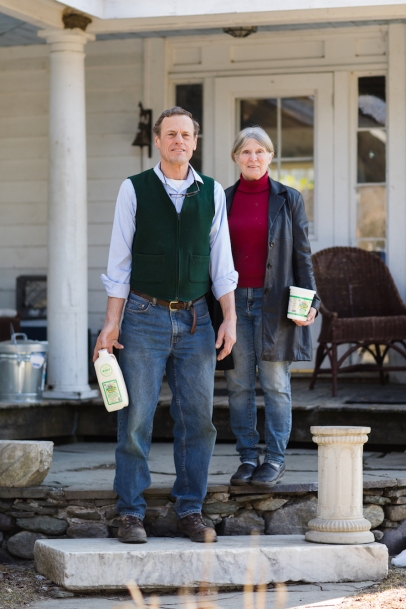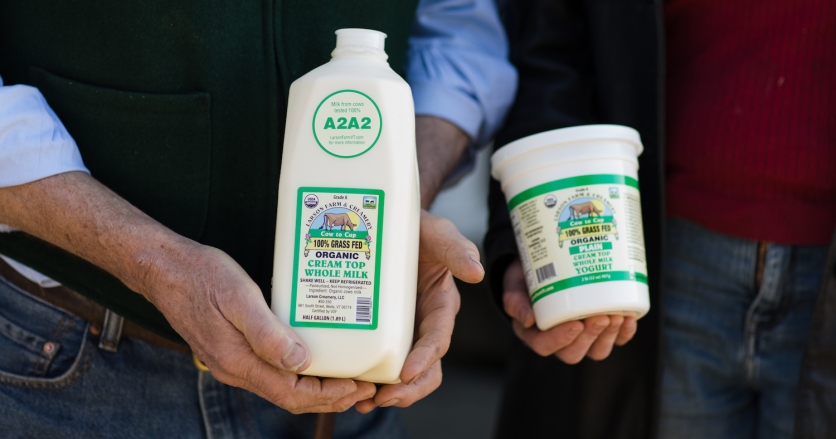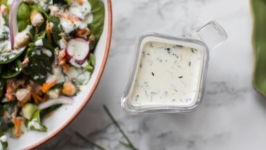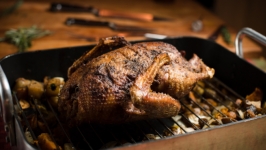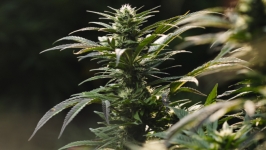Cynthia & Rich Larson
Equipment breaks, cows get sick, staff leaves, weather doesn’t cooperate. That’s farming. And it ain’t for the faint of heart.
Cynthia and Rich Larson have farmed together for more than 40 years in Wells, Vermont. And while raising herds of Jersey cows, they also nurtured and homeschooled their eight kids. They serve as passionate educators and advocates for organic grass-based farming and nutrient-dense foods. They’ve taken huge risks such as building a creamery in 2017 to process their unique A2A2 milk into yogurt, butter and gelato. And despite the vagaries of the market and inherent challenges of farming, they remain positive and forward-thinking.
So… how and why do you survive?
Rich Larson: I think it’s because every decision we’ve made over 40-plus years is based on our values, not necessarily what’s the most cost effective or labor efficient.
What shaped you as farmers?
RL: I’m a sixth-generation farmer who grew up on my family’s dairy farm in Woodstock, Connecticut. Sadly, but not surprisingly, that farm is now a gated community. My grandfather’s farm is a golf course. This was some of the best farm land on the planet, in the Connecticut River Valley. So when Cynthia and I knew we were going to farm, we headed to Vermont.
Cynthia Larson: We met at the University of Connecticut College of Ag and moved to Vermont in 1975. In those days, the mantra was “Grow more corn, pour more cement.” That was the mindset of conventional dairy and no one knew any better. We used pesticides and kept our cows inside just like every other farmer. There were no fences because cows stayed indoors. Grassfed, organic and rotational grazing were unheard of terms back then. It would take a couple more decades for those practices to move into the mainstream.
RL: We bought our farm in Wells in 1977. The buildings were in terrible condition but that’s why we could afford it. We expanded our herd to 150 cows, which was considered big back then. We grew corn continuously on the same fields. No wonder we were overrun by weeds and had intense insect pressure. Our consultant, who happened to be a chemical salesman, just told us what chemicals to spray. And so we did.
CL: When we started farming, conventional dairy was profitable. For a number of years we made a good living. But as time went on, it became less and less profitable. We went from making extra mortgage payments to making just the payments to worrying if we could even make the payment.
RL: In the early 1980s, I was mixing up a batch of chemicals to spray on the fields when I noticed the concoction had turned bright orange. It hit me: This isn’t right. Moreover, it didn’t work. Nothing could touch those weeds or combat the insects. In frustration, we decided to seed down the fields with a grass mix, just like past generations. Over time, the soils healed. We were astonished at the quality and quantity of feed we were able to raise, with no plowing, no erosion, no insecticides or herbicides. Just a little nitrogen in the spring and cow manure. Within three years, we had everything planted to grass, no corn. Everyone thought we were off our rocker. But our pastures grew high-protein grasses, our cows flourished, and our profitability increased.
CL: We sold our farm’s development rights to the Vermont Land Trust in 1990 and rebuilt the barn with that money. We focused on doing a better job with fewer cows. However, plummeting milk prices convinced us to sell our herd in 1994. Rich was also developing his career as a farm real estate appraiser, including conservation easements, which satisfied our goal of helping to preserve farmland from development.
How did you get back into business?
CL: In the late 1990s, we started raising beef just to use the land. But I got a Jersey cow for family milk. Some neighbors were interested in raw milk so we saw a business opportunity there. In 2007, we expanded from one cow to four and started selling unpasteurized raw milk direct from our farm. It’s still my favorite aspect of the farm.
RL: However, it seemed like the only way to make dairy viable for us was to vertically integrate and bring on valueadded products. So in 2017, we started the creamery. The state has been very supportive and provides access to helpful services and grants through UVM Extension, Vermont Housing and Conservation Board, and the Farm Viability Program. Sam Smith and the Viability team have been incredibly helpful to us with business planning over the years. As farmers, you’re constantly honing your vision.
CL: Our goal is help create a local food shed based on the production of nutritious food and the maintenance of healthy soils and clean water. We believe that local communities can develop their own food sheds with small businesses, which in turn will stimulate and sustain a rural economy. For example, we employ four people, which may not seem like much, but we’re a significant employer here in Wells. We have so many wonderful service people in the area who keep our infrastructure up and running. And of course, that money circulates through the community.
RL: We feel strongly that the industrial commodity market is wrong for animal welfare, the environment, nutrition and for communities. As a small dairy, we’ve always focused on providing our community with high-quality nutritious products and trying to find a way to be financially stable while doing that.
CL: We opened the on-farm B&B in Spring 2018. We actually call it a B&K with a kitchen because the guests cook for themselves. We were booked every weekend last summer with guests from around the world.
RL: We were kind of nervous when guests from India tried the ghee we produce but were greatly relieved when they said it was just like at home! What’s happening on the farm now? And explain the merits of your A2A2 milk.
RL: A2A2 milk is a specific DNA trait and we’ve been breeding for this for 12 years. A2 is the protein found in goat and human’s milk. Many people who have dairy intolerance find they can drink our milk or eat our yogurt, and it seems that this A2 milk makes the digestive difference.
CL: Vermont is fortunate to have a number of excellent yogurt makers. That’s part of why we chose to make distinct products that use certified organic milk exclusively from 100% grassfed A2 cows. When you pay a bit more for our yogurt, that extra dollar sustains the local rural economy and keeps farms like ours afloat.
What does the future hold, provided all remains stable?
CL: We’ve put everything on the line for the creamery. Do we cut our losses and walk away? With so many people and organizations supporting us, we can’t just give up. We feel the community behind us. A friend even started a GoFundMe campaign for the farm at Christmas. Now we have contributors who are part of this team. We can’t quit. We want to keep this land vibrant as part of our community food shed. Ideally we would love to find someone to take the farm over from us and move it forward. There are young or new people who want to farm, who have great visions and are willing to work this hard because they understand the rewards. It’s definitely hard for Vermont farmers to survive these days, and you can’t enter farming thinking you’ll get rich. But we have 300 acres and plenty of room for people to develop additional farm-based enterprises on our land. We’re open to new ideas.
What’s your take on Big Ag?
RL: Industrial agriculture externalizes costs to society. It degrades our water supply through pollution, causes soil erosion and contaminates the environment through spraying of pesticides and other harmful chemicals. We all pay a price for that damage. Knowing your farmers encourages you to support a healthier environment.
How has the dairy scene changed over your 60 years?
RL: We’ve seen consolidation all over the country, particularly out West, with smaller farms getting consumed by bigger and bigger feedlot operations. And as the price of milk has remained stagnant, the only way for farms to survive individually is to get bigger and take on more cows in order to produce more milk and hopefully generate more gross income. However, that results in a flooded milk market, which means dairy processors can set the price they want and pick and choose among producers.
These huge feedlot operations produce massive amounts of milk and ship out at very low prices. Advice to consumers?
CL: By now it may sound trite but it’s more true than ever: Buy local! Pay a little bit extra and support your local economy. How you spend your food dollars impacts farmers and producers directly.
RL: Consumer education is essential because food choices are longterm health choices. You can pay more for food with no pesticides and a higher level of nutrition or, down the road, pay more for your long-term health care.
Guidance for aspiring farmers?
RL: Get a business plan. Be creative and think outside the box to find something that’s not being grown, raised or produced. Get experience on other farms or businesses, then rent or lease land. If you’re an entry level farmer, don’t initially think of farm ownership. If you decide to buy, the Vermont Land Trust Farmland Access Program is a good place to start. And use the excellent resources Vermont offers. Take it slow and invest your resources in production units (i.e., animals, used equipment, land to rent). These steps greatly reduce risk and allow you to focus on learning the production techniques, fi guring out which products will sell and gaining the experience necessary to ramp up to the next level.
Challenges aside, what are the joys?
RL: When I walk into the sales room and someone tells me how our products have improved their life. It’s a great pleasure. I also love mowing hay. It’s always a beautiful day, birds are singing, and I’m going back and forth over the field creating corduroy rows of cut grass. Call it the optimism of harvest. And of course, there’s something about milking cows, those wonderful individual creatures.
CL: Moving the cows from pasture to pasture throughout the day. They’re so happy to see us coming and they almost trip over themselves to get that first delicious bite.
Favorite time of day on the farm?
RL: I go to the barn after dinner each night to check on the girls. I make sure the bulk tank is turned on and the lights are turned off. The cows come up to me and want to get scratched. It’s a time of meditation for me, a chance to reflect.
CL: Sometimes day to day I forget why I do this, but doing chores reminds me why I love farming so much.
RL: There are three legs to sustainability: financial, environmental and social. We’re justdoing our part to make the world a better place through good food and community.
FIVE RAPID FIRE
Breakfast today?
Richard Larson: Salad, oatmeal, kefir with blueberries
Favorite childhood meal?
RL: Steak
Cake, pie or cookies?
RL: Apple pie
Guilty indulgence in food or drink?
RL: Wine
Late-night snack?
RL: Milk


